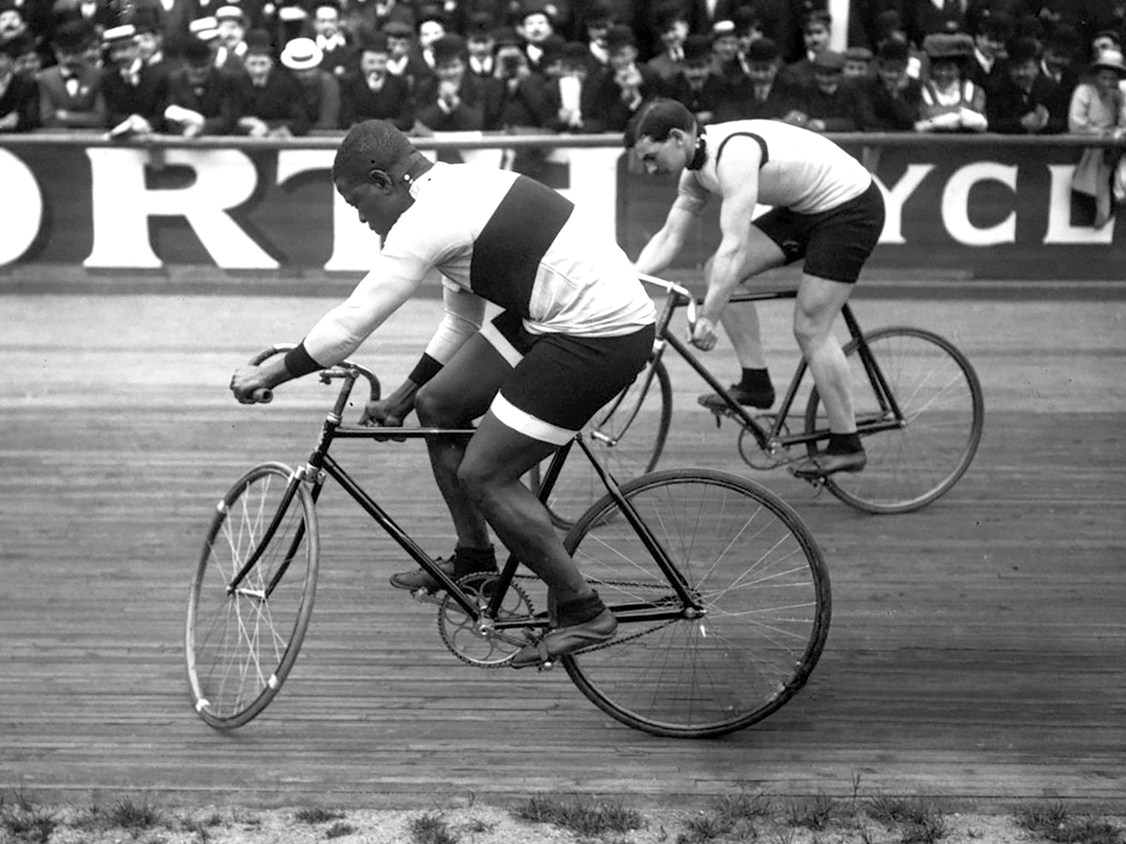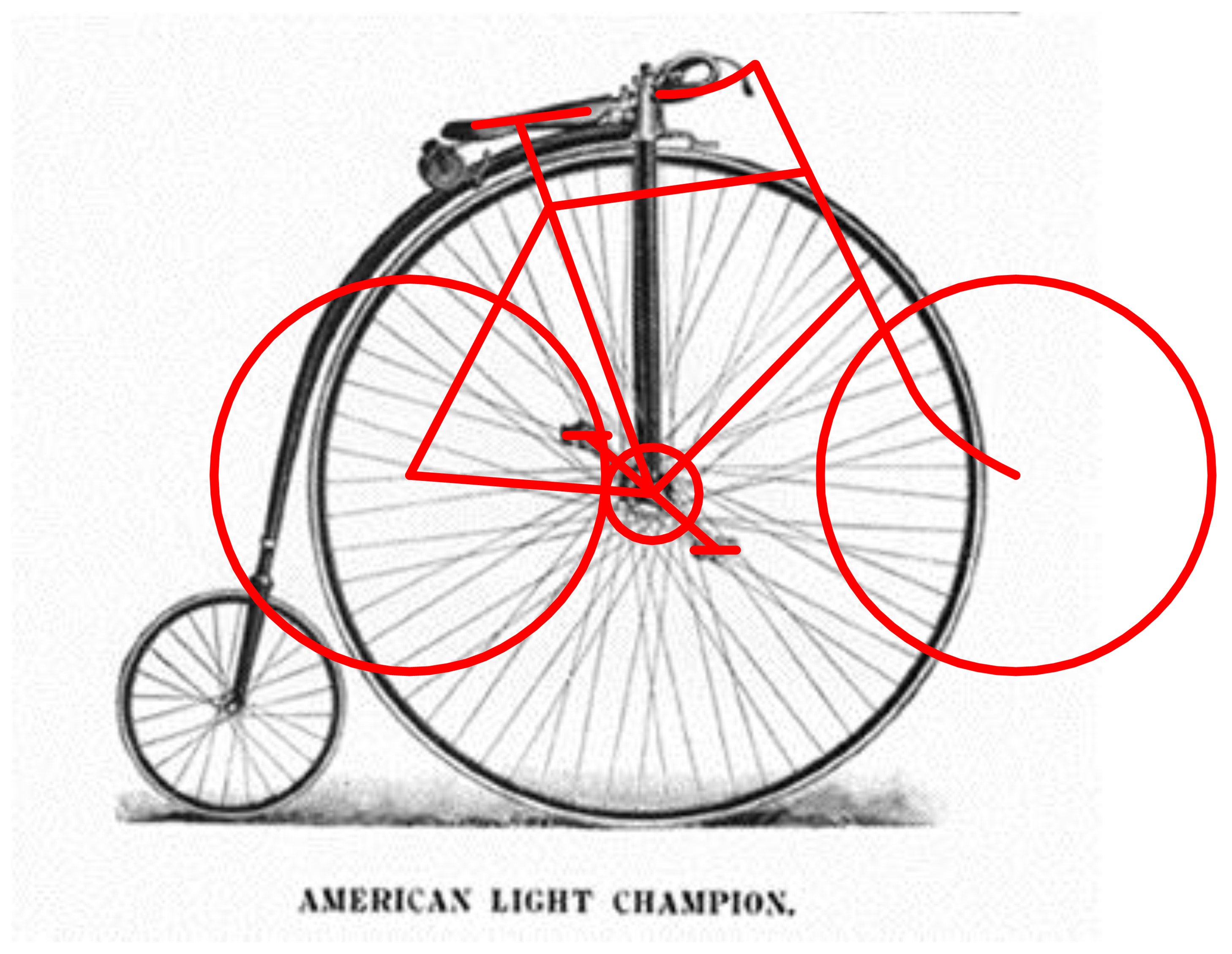Did you ever wonder why?
 Mon, January 23, 2023
Mon, January 23, 2023
 Major Taylor and Leon Hourlier, Buffalo Velodrome, 1909Did you ever wonder why bicycle frames of the early 1900s had such “Laid Back” or “Slack” seat angles? (See the above picture.)
Major Taylor and Leon Hourlier, Buffalo Velodrome, 1909Did you ever wonder why bicycle frames of the early 1900s had such “Laid Back” or “Slack” seat angles? (See the above picture.)
The forerunner of the chain driven bicycle was the “Ordinary” or High Wheeler. It was the first enthusiasts’ bike, and it was initially faster than the chain driven bike. When that big wheel gathered momentum, it was possible for a fit athlete to maintain 20 mph.
It wasn’t until pneumatic tires were invented that the chain driven bicycle became faster and was widely accepted. The early chain driven bikes, were designed to seat the rider in the same position they had been used to on the High wheeler. (See picture below.)

On the high wheeler with the handlebars directly above the pedals, there was no other option but to sit some distance back behind the pedals. However, it was realized that with the chain driven bike, there was no need for the rider to sit upright, and it was an aerodynamic advantage for the frame to be made longer.
Frames were now made in different sizes, (Heights.) to accommodate different size riders, and lower priced bicycles were being massed produced. There was a need for some kind of standardization.
Top tubes became level by the 1900s, as this was the framebuilders point of reference from which all other angles were measured. Level top tubes were standard for the next 90 years.
Head and seat angles did become a little steeper over the years, but this notion that one had to sit back in order to pedal fast and efficiently still prevailed in the 1950s when I started racing. Standard frame angles were 73 head and 71 seat, throughout the entire range of frame sizes.
Frame lugs were heavy steel castings, machined on the inside to accept the tubes at these standard angles. It was not cost affective to make lugs in different varying angles. It was established probably around the 1930s that 73 degrees was the ideal head angle for a road bicycle, this is still true today.
The reason for the seat angle being 2 degrees shallower was because when a framebuilder made a larger frame, the top tube became longer because the head and seat tubes were diverging away from each other.
“These standard angles were not for the benefit of the rider, but for ease of construction for the framebuilder.”


















Reader Comments (4)
I suspect that saddles were very different back then.
Even today, Brooks saddles are very different to the standard plastic racing saddle. When I bolted a Brooks to my bicycle, I had to change the seatpost too, previously I had a zero setback post but with the Brooks I needed a standard seatpost with seatback as the saddle puts you in a more forward position.
I suspect, old saddles were designed like Brooks, they compensated for the slack seat tube angle somewhat.
Thank you, this aspect of the frame geometry I had not even considered. However, I suspect that there must be other reason in addition: e.g. a flat steering head angle (with corresponding fork rake to reduce trail) has advantages in the "damping" on bumpy roads.
The seatposts at that time had the shape of a (mirrored) "7" on which the saddle could be pushed forward more than a hand width. The posture of the driver could therefore already correspond to a more "modern".
It is interesting to ask what would have happened if the bicycle chain had been introduced not at the time of the "Ordinary", but already 30 years earlier at the time of the "Velocipede" (pedals also at the front wheel hub but two equally large wheels). Would we be riding front-wheel drive recumbents today as the "normal" bicycles?
Thank you, this aspect of the frame geometry I had not even considered. However, I suspect that there must be other reason in addition: e.g. a flat steering head angle (with corresponding fork rake to reduce trail) has advantages in the "damping" on bumpy roads.
The seatposts at that time had the shape of a (mirrored) "7" on which the saddle could be pushed forward more than a hand width. The posture of the driver could therefore already correspond to a more "modern".
It is interesting to ask what would have happened if the bicycle chain had been introduced not at the time of the "Ordinary", but already 30 years earlier at the time of the "Velocipede" (pedals also at the front wheel hub but two equally large wheels). Would we be riding front-wheel drive recumbents today as the "normal" bicycles?
The blog explains why early 1900s bicycle frames had "laid back" or "slack" seat angles. Initially, the high wheeler's design, which required riders to sit far behind the pedals, influenced early chain-driven bike designs. As pneumatic tires improved chain-driven bike speeds, designers began to adjust frame geometry for better aerodynamics, leading to the standardization of frame angles with level top tubes. Despite advancements, the trend for steeper head angles and shallower seat angles persisted. The discussion connects to modern custom bikes, like the se bikes big ripper, showing how bike design has evolved over time.